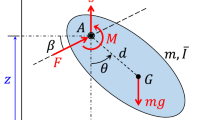Summary
-
1.
Using high speed film analysis (500 frames/s) to investigate the head nodding movement during tethered flight inLocusta shows that the position of the wind-sensitive head hairs with respect to the flight direction is altered by 5.5° in the rhythm of the wing beat (Fig. 2).
-
2.
Wind measurements in the region of the hair fields demonstrate that the wind reaching the hairs during flight is modulated by the animal's own wing beat. The modulation has a peak-to-peak value of 0.6–1.0 m/s (Fig. 3).
-
3.
An airstream with its speed modulated by these values was used to stimulate the wind-sensitive hairs to analyse the steady-state response during tethered flight in animals with the antennae removed (Fig. 1). In these entrainment experiments absolute coordination (a relation of locked phase) between the wind modulation and the flight oscillator is found in a range of about 3 Hz around the intrinsic flight frequency. At frequencies both above and below this range, relative coordination (a relation of preferred phase) is obtained (Figs. 4–7).
-
4.
The dynamic response to step changes in the modulation frequency was tested. There is an immediate reaction, but it takes several wing beats to reach the new steady-state (Fig. 8).
-
5.
When flight was elicited while a modulated wind stream was already blowing, the first wing beat occurred in a preferred phase with respect to the stimulus modulation (Figs. 10 and 11).
-
6.
To understand the generation of the flight pattern, the whole flight oscillator must be considered as a cooperative system of central neuronal, sensory (proprioceptive) and mechanical components (Fig. 12).
Similar content being viewed by others
Abbreviations
- TCG :
-
tritocerebral commissure giant
References
Bacon J, Möhl B (1979) Activity of an identified wind interneurone in a flying locust. Nature 278:638–640
Bacon J, Möhl B (1983) The tritocerebral commissure giant (TCG) wind-sensitive interneurone in the locust. I. Its activity in straight flight. J Comp Physiol 150:439–452
Bacon J, Tyrer M (1978) The tritocerebral commissure giant (TCG): a bimodal interneurone in the locust,Schistocerca gregaria. J Comp Physiol 126:317–325
Bacon J, Tyrer M (1979) Wind interneurone input to flight motor neurones in the locust,Schistocerca gregaria. Naturwissenschaften 66:116–117
Burrows M (1975) Monosynaptic connexions between wing stretch receptors and flight motoneurones of the locust. J Exp Biol 62:189–219
Camhi JM (1969a) Locust wind receptors. I. Transducer mechanics and sensory response. J Exp Biol 50:335–348
Camhi JM (1969b) Locust wind receptors. II. Interneurones in the cervical connective. J Exp Biol 50:349–362
Gettrup E (1965) Sensory mechanisms on locomotion: the campaniform sensilla of the insect wing and their function during flight. Cold Spring Harbor Symp Quant Biol 30:615–622
Gewecke M (1972) Antennen und Stirn-Scheitelhaare vonLocusta migratoria L. als Luftströmungs-Sinnesorgane bei der Flugsteuerung. J Comp Physiol 80:57–94
Gewecke M (1975) The influence of the air-current sense organs on the flight behaviour ofLocusta migratoria. J Comp Physiol 103:79–95
Gewecke M, Heinzel HG (1980) Aerodynamic and mechanical properties of the antennae as air-current sense organs inLocusta migratoria. I. Static characteristics. J Comp Physiol 139:357–366
Heinzel HG (1978) Aerodynamische, mechanische und elektrophysiologische Untersuchung der Heuschreckenantenne als Luftströmungs-Sinnesorgan. Doctoral thesis, Universität Düsseldorf, FRG
Heinzel HG, Gewecke M (1979) Directional sensitivity of the antennal campaniform sensilla in locusts. Naturwissenschaften 66:212–213
Holst E von (1939) Die relative Koordination als Phänomen und als Methode zentralnervöser Funktionsanalyse. Ergeb Physiol 42:228–306
Horsmann U (1981) Flugrelevante Afferenzen und ihre Verarbeitung bei der Wanderheuschrecke (Locusta migratoria L.). Diplomarbeit, Universität Köln, FRG
Jensen M (1956) Biology and physics of locust flight. III. The aerodynamics of locust flight. Philos Trans R Soc Lond [Biol] 239:511–552
Kien J, Altman JS (1979) Connections of the locust wing tegulae with metathoracic flight motoneurons. J Comp Physiol 133:299–310
Möhl B, Bacon J (1983) The tritocerebral commissure giant (TCG) wind-sensitive interneurone in the locust. II. Directional sensitivity and role in flight stabilisation. J Comp Physiol 150:453–465
Möhl B, Nachtigall W (1978) Proprioceptive input on the locust flight motor revealed by muscle stimulation. J Comp Physiol 128:57–65
Smola U (1970) Rezeptor- und Aktionspotentiale der Sinneshaare auf dem Kopf der WanderheuschreckeLocusta migratoria. Z Vergl Physiol 70:335–348
Tyrer NM (1981) Transmission of wind information on the head to the locust flight motor neurons. Adv Physiol Sci 23:557–571
Tyrer M, Bacon J, Davies CA (1979) Sensory projections from the wind-sensitive head hairs of the locustSchistocerca gregaria. Cell Tissue Res 203:79–92
Varanka I, Svidersky VL (1974a) Functional characteristics of the interneurons of wind-sensitive hair receptors on the head inLocusta migratoria L. I. Interneurons with excitatory responses. Comp Biochem Physiol [A] 48:411–426
Varanka I, Svidersky VL (1974b) Functional characteristics of the interneurons of wind-sensitive hair receptors on the head inLocusta migratoria L. -II. Interneurons with inhibitory responses. Comp Biochem Physiol [A] 48:427–438
Weis-Fogh T (1949) An aerodynamic sense organ stimulating and regulating flight in locusts. Nature 164:873–874
Weis-Fogh T (1956) Biology and physics of locust flight. IV. Notes on sensory mechanisms in locust flight. Philos Trans R Soc Lond [Biol] 239:553–584
Weis-Fogh T (1964) Control of basic movements in flying insects. Symp Soc Exp Biol 18:343–363
Wendler G (1974) The influence of proprioceptive feedback on locust flight co-ordination. J Comp Physiol 88:173–200
Wendler G (1978a) The possible role of fast wing reflexes in locust flight. Naturwissenschaften 65:65
Wendler G (1978b) Lokomotion: das Ergebnis zentral-peripherer Interaktion. Verh Dtsch Zool Ges 1978:80–96
Wever R (1960) Possibilities of phase-control, demonstrated by an electronic model. Cold Spring Harbor Symp Quant Biol 25:197–206
Wilson DM (1961) The central nervous control of flight in a locust. J Exp Biol 38:471–490
Author information
Authors and Affiliations
Additional information
This paper is dedicated to the memory of Erich von Holst on the twentieth anniversary of his death
Rights and permissions
About this article
Cite this article
Horsmann, U., Heinzel, H.G. & Wendler, G. The phasic influence of self-generated air current modulations on the locust flight motor. J. Comp. Physiol. 150, 427–438 (1983). https://doi.org/10.1007/BF00609569
Accepted:
Issue Date:
DOI: https://doi.org/10.1007/BF00609569




